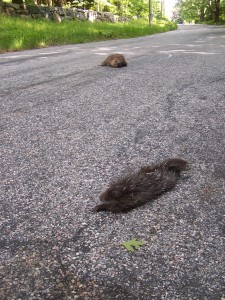It’s Only Natural
I Break For Insects
By Shelley Harms
October is the time when woolly bears cross the road. I mean the caterpillars (though a large actual bear was killed on Route 44 this summer). And yes, I watch for the little crawly bugs and, if I don’t brake, I at least try to steer so the wheels won’t crush them. Same thing on froggy nights – you know what I’m talking about, when it’s warm and rainy and the frogs are hopping all over the roads. I hate it when I squish one. I feel even worse when it’s a squirrel or a rabbit, they seem to literally throw themselves under my wheels. My slow driving and sudden swerves may be why my family hates riding with me, though I assure them that I’m always aware of other cars. I don’t want to kill any humans either.Roads are vectors of death for animals. Every year, 150 people die and 10,000 are injured in collisions with animals, but the animals fare much worse. Motor vehicles kill an estimated one million mammals, birds, reptiles, and amphibians per day in the United States, hundreds of millions a year. Add insect mortality and we would be talking billions. Motor vehicles are the greatest cause of human-caused wildlife mortality in America.
When you think about it, animals have not had very long to adapt to paved roads and high-speed traffic. Just 100 years ago, not many people owned cars, the cars didn’t go that fast, there weren’t as many roads and most roads were unpaved. Today, one of every two people in the U.S. has a car, and nearly 4 million miles of roads criss-cross the United States. The farthest any animal can get from a road in the lower 48 states is 22 miles, in the heart of Yellowstone National Park.
Animals must cross roads. Large mammals that range forty to eighty miles cannot range without making many road crossings. Juvenile mammals of all sizes, once they outgrow the den, must cross roads to find and establish new territories. As roads frequently separate the upland where amphibians live from the wetlands where they breed, hatch and grow, amphibians must cross roads.
Unfortunately, animals are also enticed to roads by people. Throwing an apple core or half-eaten fast food meal out the car window may lure an animal to its death. Squished animals attract more animals including many types of birds, who often are hit in their turn.
While roadkill is little-studied, a few studies have yielded some interesting nuggets: for example, traveling over 45 miles per hour substantially increases the chances of a collision with an animal; roads with more truck traffic have a higher volume of dead animals; and, incredibly, six percent of drivers actually try to hit animals on the road rather than avoid them.
In the hopes that Norfolk Now readers are not among those who try to kill animals while driving, I offer these tips from the Humane Society of the U.S. for reducing the carnage:
• Be especially watchful for wildlife at dawn, dusk and in the first hours after darkness falls. Many species are most active at these times.
• Try to slow down: go less than 45 mph where possible.
• Scan the roadside edges ahead of your car, and slow down if you see movement or the reflection of an animal’s eyes.
• Don’t throw food out of your car.
• Be particularly watchful for wildlife along roads that border natural habitats and wherever roads cross streams.
• Assume that animals do not know how to get out of your way. Young animals, in particular, do not recognize cars as a threat.
• Never assume that an animal is alone. Where there is one animal crossing, there may be others following.
Give Wildlife a Brake! Week is November 3-9. It is timed to coincide with the end of daylight savings time, when more cars are on the road at dusk. The Humane Society says that “driving with wildlife in mind is as important a safety message at this time of year as changing the batteries in smoke detectors. It would save many animal lives (and a few human ones as well) if drivers ratcheted up their road awareness when they dialed back their clocks.”

